Indian contemporary artist Chetnaa wants to capture the essence of a form and not merely its outward appearance, via her process.
While developing one’s art, an artist is constantly moved psychologically by not only other artists but also their own personal surroundings and environment. In my case, since I travel a lot in the city, it is my constant quest to abstract the cityscape to a form of minimal geometric purity that could be visually consumed in an instant.
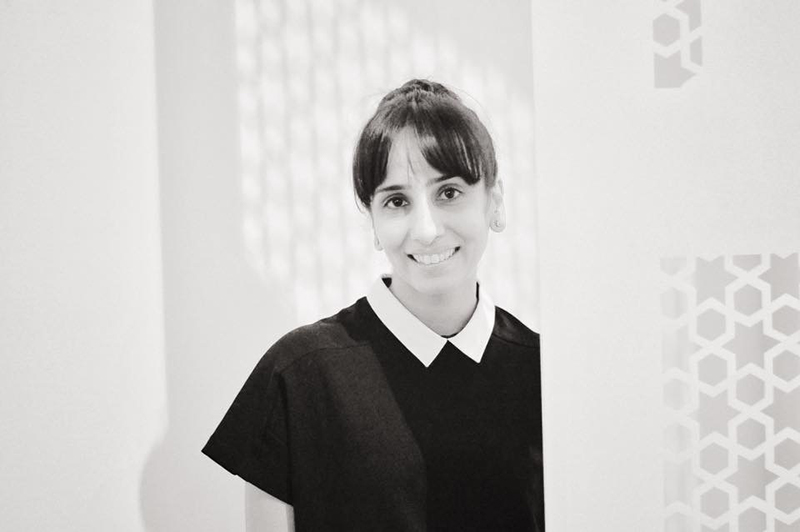
Please tell us a little about yourself. What brought you to the world of art?
I was a commerce student and while I was pursuing my B.Com, I started working in a business intelligence firm. I soon realised that this was not my calling and I wanted to take up art as a career. Even though I always had an interest in art, I didn’t get the right kind of guidance early on. Once I decided to pursue this, I started researching on how to become an artist and found out about the BFA programme at College of Art in Delhi. The first time I applied, I didn’t get through and I kept re-applying for the next two years but without any luck. Meanwhile, Amity School of Fine Arts was also opening and I decided to enrol in their programme. Even though Amity wasn’t my first choice, I have to say that I got the right teachers at the right time. Once I finished my bachelors I was still keen on going to College of Art, so I applied for their Masters programme. To my surprise I got through in the first attempt!
How do you deal with the conceptual difficulty and uncertainty of creating new work?
Whenever I decide to take up a new medium or a new subject I tend to spend a lot of time on just research. Before beginning anything new I believe it’s important to know the strengths and the weaknesses of a subject. Rest you learn as you go. You tend to learn a lot from the mistakes you make.
Let’s talk about the evolution of your practice over the years. Tell us about your commitment to your current medium. What would you call your style?
As an artist one tends to explore and experiment with various mediums and techniques. I too have experimented and used a variety of mediums over the course of my practice. Pen and ink on paper remains one of my favourites and I have combined it with various other mediums to enhance my practice. Paper as a medium is my forte. I have extensively explored white-on-white: of that of the surface of paper, to create recessions and accessions and, thereby, playing with shadows and depths of just the white of the paper. During my masters I also experimented a lot with thread on paper and, lately, I am back at it too.
My current practice is a multi-faceted oeuvre. I am trying to combine mediums that I have worked with over the years. The medium I am currently occupied with is graphite. I have coupled the same with pen and ink on paper, paper on paper, roads maps and so on. If I were to give a name to my practice I would simply called it minimal geometric non representative art.
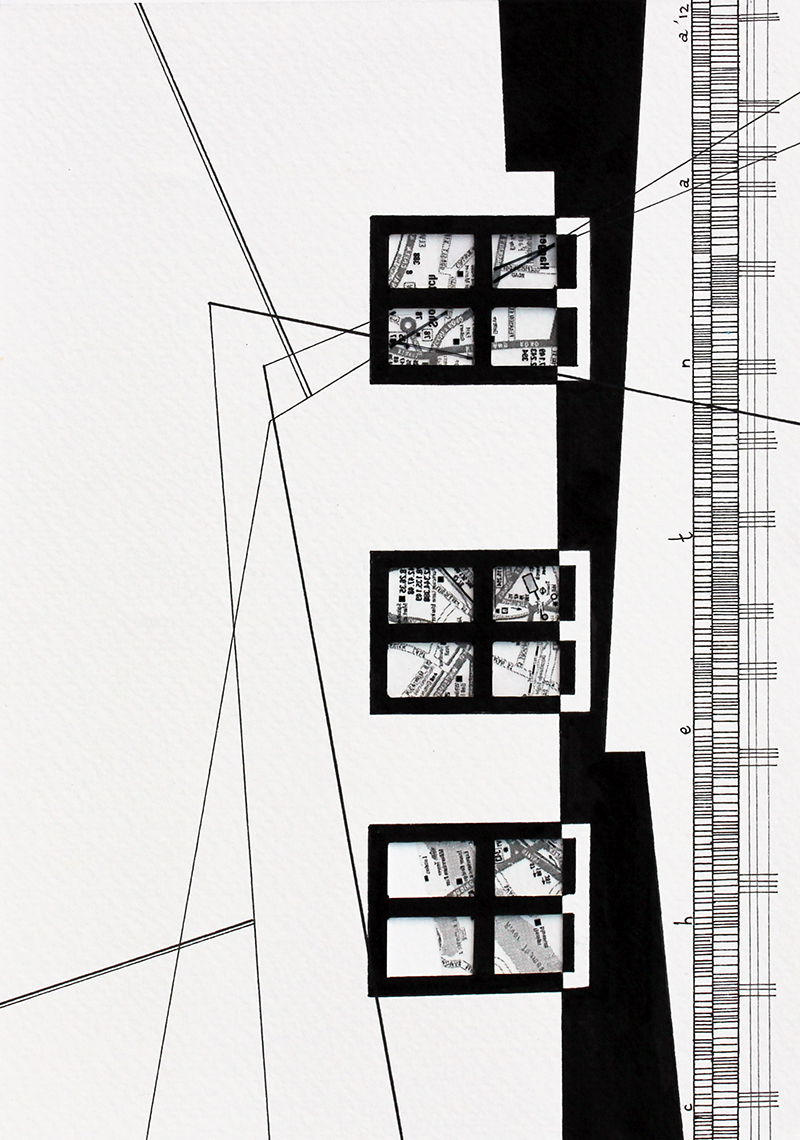
Experiment Lines 2, Pen & ink on paper, 6 x 8 in. 2012.
Let’s talk about your frameworks, references and process. What inspires you?
Art for me has always been an attempt to capture the essence of a form rather than its mere outward appearance. An abstractionist by nature and a minimalist in practice, I try to capture and reflect the city’s architecture deconstructed into horizontals and verticals.
Each work is a harmonious order in the layering of maps, lines and angles – drawn on and threaded through the paper, flexible and tenuous all at once. I have no explanation to go along as to why a line has been overlaid over another in the manner that it is. The works are rather a representation of the deconstruction of the complex city grid into a simple and minimalist array of vertical and horizontal moving points and its trajectory
Let’s talk about your career, or if you prefer artistic journey. What were your biggest learning and hiccups along the way?
When I started my career, I was pricing my works very high. In hindsight, I think it is more important to ensure that your work goes places. If it’s hanging in someone’s house, you know that there are people who love it and they want to get up to it every morning. At the end of the day, that is more important. Over time I have reduced it a lot and now I have settled at a price point that I am comfortable with.
Today, in fact I am mentoring a lot of young artists’ on how to present their works, how to approach a gallery, how to price their works and other such things. Whatever I have learned the hard way over a decade I am extremely happy to share my knowledge with my peers.
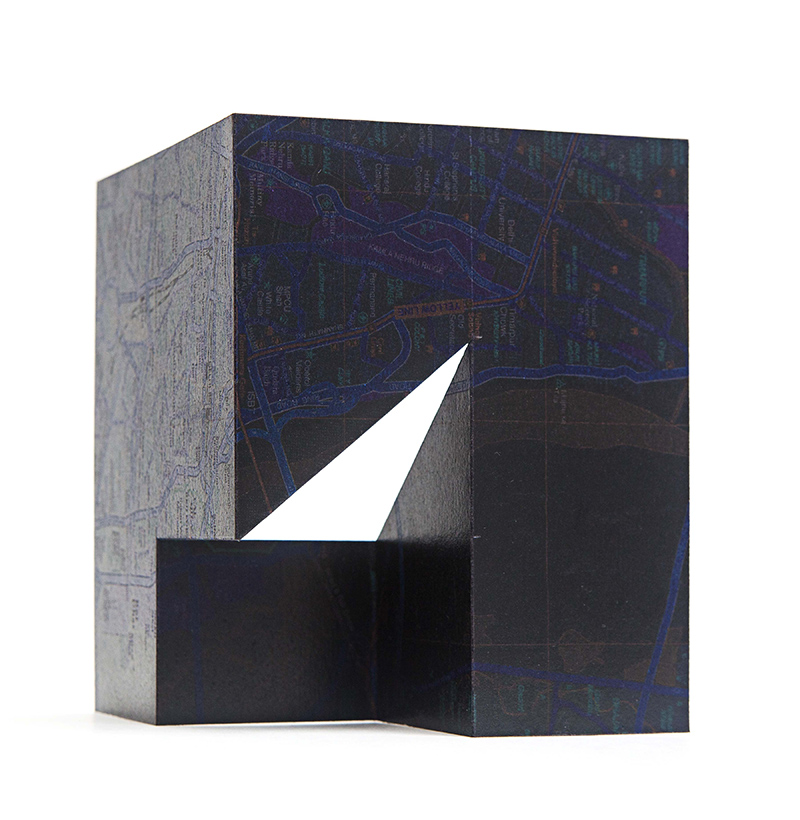
Series – Fold, Unfold – The Grid V, Photographic print on archival paper, Sizes Variable, 2016.
How does your audience interact and react to the work you put out into the world?
I am often asked as to how I would describe my work or the underlying story that people believe would facilitate a reading of my works. I feel that the works speak for themselves and do not need any long-winded narration to support them.
What are you looking for when you look at other artists’ work? Which shows, performances and experiences have shaped your own creative process? Who are your maestros? Whose journey would you want to read about?
While developing one’s art, an artist is constantly moved psychologically by not only other artists but also their own personal surroundings and environment. In my case, since I travel a lot in the city, it is my constant quest to abstract the cityscape to a form of minimal geometric purity that could be visually consumed in an instant. I would like to quote Oscar Wilde here from his essay, The Soul of Man Under Socialism: “A work of art is the unique result of a unique temperament. Its beauty comes from the fact that the author is what he is. It has nothing to do with the fact that other people want what they want. Indeed, the moment that an artist takes notice of what other people want, and tries to supply the demand, he ceases to be an artist, and becomes a dull or an amusing craftsman, an honest or dishonest tradesman. He has no further claim to be considered as an artist.”
Last year at the India Art Fair, I displayed a set of 51 works which I had made at my residency in Scotland and a well-known art critic and curator came up and said, “I see a young Zarina (Hashmi) emerging here.” I took it as a compliment because I admire her works and I like what she does. And while I may be inspired, I do think there is a difference between her work and mine. She is working with displacement and memories of her past through non-representational medium dissecting space, while I dissect space and shape. I guess there are similarities in our practice when it comes to conceptualising and producing a work.
I am currently reading the biography of Agnes Martin.
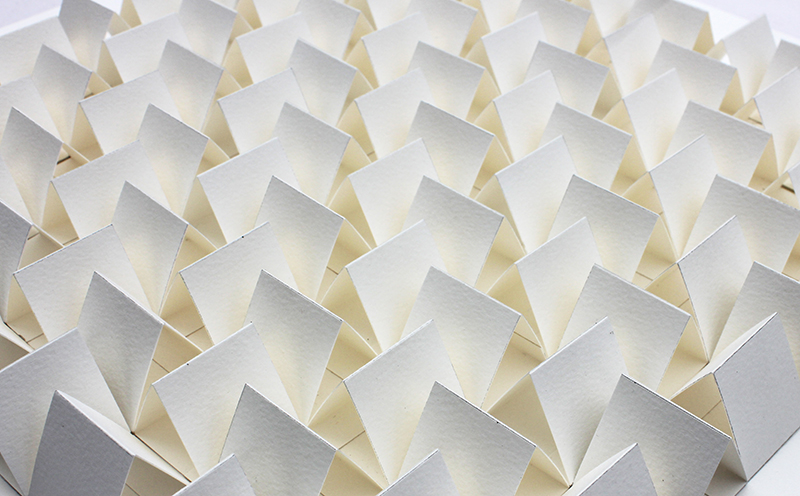
Detail: Fold, Bend & Overlap.
What was your first sale? Do you handle the commercials yourself or is it outsourced to a gallery or an agent?
My first sale was while I was still studying my master’s at the College of Art. During our annual display a representative from Art Indus Gallery asked me to get my works to their gallery. And to my surprise they managed to sell all my line drawings in one go to a single collector. That was a big high for me and a kind of a reassurance to continue practicing what I was doing.
Currently, I am not associated with any gallery but keep participating in group shows with various galleries. With regards to the commercials, if a buyer or a collector approaches me and that particular work is with the gallery, I always forward them to the gallery. I believe both the artist and the gallery have to be honest to each other with respects to sales. The number of people, buyers, or collectors a gallery can reach I might not be able to. And quite frankly I would just like to produce the works without bothering much about the commercials.
How many works do you make in a year? How many would you like to be making?
There is no limit or set number of works that I make in a year or would like to make. What’s important is to keep making works, irrespective of whether they will be showed anywhere or not. One has to constantly increase and improve one’s oeuvre.
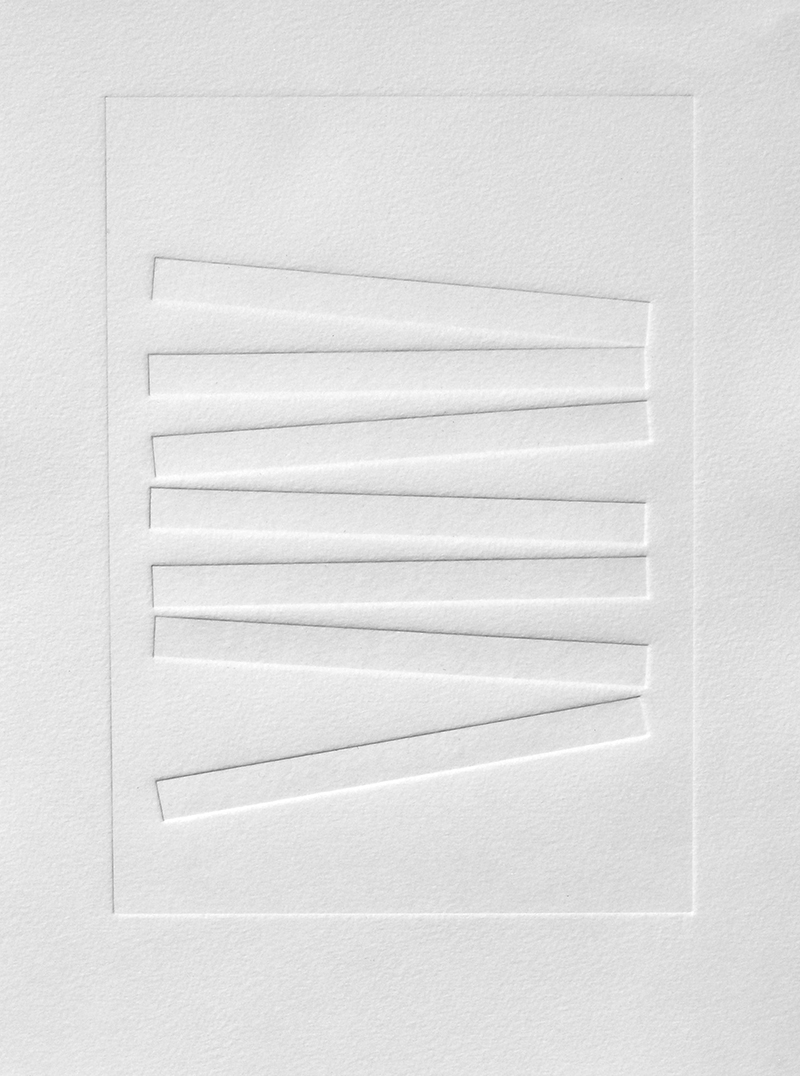
Series – Impression VII, Editions-3, Embossing on paper, 10 x 14in. 2018.
What is the best piece of advice you have received? Why was it helpful?
It has just been a year since I got in touch with Anupa Mehta, a curator from Bombay. She used to run a gallery but now she is an independent curator and an art consultant. When she asked to see my works, I sent her an e-catalogue. She politely scolded me via email saying that after practicing for so many years, I shouldn’t still be sending out e-catalogues. She told me that this was not the right way to send works. So, with her guidance, I prepared a presentation listing all the works neatly in categories and arranged chronologically by year. Recently, I sent this PPT to a gallerist and she was so happy that she almost offered me a solo show! Only then did I realise that extra effort in preparing a PPT actually made a lot of difference, as opposed to sending an e-catalogue like I used to. It might not work every time, but in this case it definitely left an impression. I was very grateful to Anupa for helping me at the right time. Sometimes one doesn’t realise but little things and advice takes you far in your career.
Tell us about your studio? Could you describe your usual work day in the studio?
I have taken up a one bedroom apartment and converted it into a studio. It’s a beautiful apartment and just ten minutes away from my residence. Most essentially it has a lot of day light pouring in from every corner. Also, since it is surrounded by lots of greenery, I find it very calming. I normally get to my studio in the mornings and carry my lunch with me. There are days when I don’t feel like working, so I end up reading a book. I am in my studio till about six or seven in the evenings. I work, I read, I write and, sometimes, just relax with a nice cup of coffee.

Exhibition View: Noir.
Are you more of a studio artist or naturally collaborative by nature? How do you feel about commissions?
For the past decade or so I have continued to work from my own space and now it has been over four-five years that I have moved my studio away from home. I find working from my studio comfortable and quite meditative.
With regards to collaborations, I often tend to use specialised studio spaces like print studios for my works, but so far I have hesitated from collaborating. Commissioned works in my opinion are essential sometimes, especially when you are facing an artist block – they offer a good break!
What are you working on now? What’s coming next season?
I am currently exploring a lot of new mediums. When one is working in the studio, you tend to explore and experiment in various mediums all at once. So, currently in my studio I am working with graphite on paper, thread on paper and three dimensional white-on-white paper structures. It’s very interesting how all these mediums are different and yet they intersect at some point, bringing forth my language.

Exhibition View: Noir.
Is there any topic lately that you would like to be mentored on?
I am currently exploring a lot of printmaking techniques. And whenever possible I tend to participate in workshops as well events related to printmaking. So that’s one medium where I feel I can do more.
Before you go – you might like to browse our Artist Interviews. Interviews of artists and outliers on how to be an artist. Contemporary artists on the source of their creative inspiration.








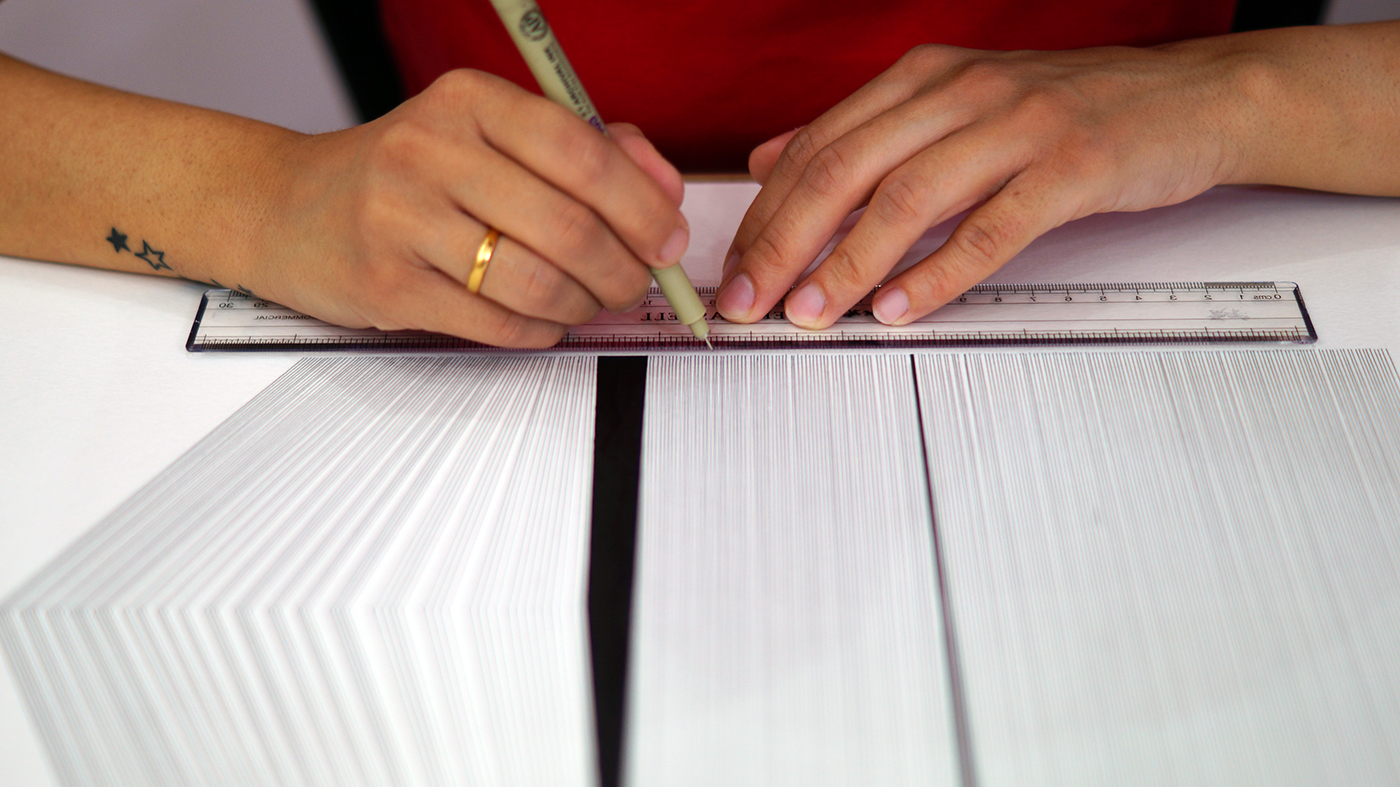



Add Comment